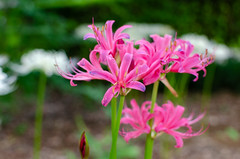In my last post on the topic, I started off reflecting on the sheer variety of mirrorless (or CSC, compact system cameras), and ended up seeing the spirit of playful creativity they bring. Today, I want to get back to the camera themselves. Like many, I continue to be a DSLR user with a compact, or compacts for backup. As my needs changed, I ended up getting more bodies to meet them, not to mention lenses, attachments, batteries and so on, this being life for a photo enthusiast or pro, you simply want the best tool for the job. Now we have a whole new range of possibilities opened up by this growing range of CSCs, which while they can’t yet, in my opinion, replace a DSLR in many areas, in others they may even be better than one, which isn’t something I could say about many compacts, by virtue of being ligher, smaller and much, much more discrite.
Interestingly, despite all being in their own way attractive and exciting they bring a new range of pros and cons, not just in the camera themselves, but as systems. I’ll go into what I see these as being below. By the way, the order is based around their approximate date of introduction, though I do save one for last. I’ll get onto which I like best in the conclusion, which if you’re anything like me you’ll scroll right down to, although I think you’ll be able to guess from the various summaries.
You’ll notice that the features of the camera are generally in the ‘pros’. Why? Well, to do anything else would just end up repeating them, as it’s generally the features that are lacking, or don’t work, that end up being cons. I’ve also tried to focus on balancing usability concerns along with IQ, to my mind (of course!), as unlike the bulky but ergonomically time-tested and proven DSLR’s, these are all about the portability, with IQ arguably coming a close second. Many of these cameras would never survive going toe to toe with a modern DSLR in IQ terms (though a few of them, interestingly enough may even surpass them), but then again, they don’t have to, it being enough they are all far, far better than even a ‘high end’ (1/1.7″ sensor) compact. With each of them I list the system name and crop factor compared to 35mm full-frame. It may be a dated frame of reference in our digital world, but it’s the only commonly-agreed one we have, so it serves a purpose. So here we go, an early 2012 survey of the CSC options of our time…
CSC Systems Today

Probably the nicest CSC of the bunch, but not necessarily the most powerful.
Olympus (Pen, Micro 4/3 mount, 2x)
Pros- The Pens offer a beautiful range of bodies, with retro-styling and built-in shake reduction (uniquely, as other manufacturers limit this to the lens-based stabilisation). As cameras to use, this is very attractive, as unattractive models just aren’t much fun. Being M 4/3, the longest standing CSC system and arguably the inspiration behind the others, there is already a great and growing selection of lenses, far better than any other CSC system. With the Panasonic made, though Leica-designed 20mm f/1.7, 25mm f/1.4 and 7-14mm wide-angle, you have some of the best lenses anywhere, certainly for the price. Olympus is catching up too, after initial efforts just to make lenses smaller, ending up with their decent folding zooms, they are now making world-class optics again, just as they did for the original 4/3 system, in the 12mm f/2 and 45mm f/1.8. What is unique about these lenses, aside from their relatively very small size, is their small price. there is just no way you could make lenses of this quality in this price range for a full-frame, or even probably an APS-C camera. Simple reason- a sensor that is easier to design for and much less glass needed to cover it.
The latest bodies have very fast contrast-detect autofocus, which works well in good light and with stationary subjects. Due to the inbuilt IS and styling, they are a favourite for using classic MF lenses with adapters, or perhaps even newer ones as well. Their software also offers excellent jpeg conversion, wonderful menus and creative ‘picture styles’, which along with the fantastically styled bodies, makes for a uniquely attractive photo-taking machine. Throw on a nice, stabilised prime and you could be in photographer’s heaven, especially with the recent EP-3. Very soon, the high-end, weather-sealed EM-5 will be released, along with a ‘new’ 16mp sensor and 5-axis stabilisation, built in viewfinder and weatherproofing., though until it comes out, we won’t know for sure how good it is.
Cons- The current highest end body (EP-3) is pricey, whilst older models, which are still on sale, have much worse AF. It uses an older, probably even 4-year old 12mp sensor, so you have to wonder if you are getting good value for money with it. No inbuilt EVF, just fairly low-resolution LCDs for focusing. There is a good external EVF, but it’s bulky, which seems to defeat the purpose of a small system. Also, the M 4/3 sensor is smaller than APS-C, as found in most DSLRs, making for worse dynamic range, high ISO and making it harder to limit the depth of field. The lack of phase-detect AF means the camera can’t do motion tracking very well, making them a poor choice for sports, crawling babies, even flowers swaying in the wind. If you found yourself missing a lot of shots on your compact due to movement, you may see the same thing happening here.
Another con is that despite being a large and growing system, it still lacks what many pros need- bright 2.8 zooms. Even if it had them, they would need to be at least f/2 to compensate for the smaller sensor, as are Olympus’s M4/3 zooms. They are probably (in f/2.8) coming though, as Panasonic has already shown prototypes at the latest CES show. Due to the laws of physics, they’ll be best balanced on the larger bodies making for a relatively compact system rather than a small one, as cropped-sensor DSLR users have been enjoying over the past decade, only more so.
Summary- Olympus offers the nicest bodies in my opinion, with the design, stabilisation and software. With the right lenses, you could really by in a photographer’s Nirvana. The only things holding me back right now are the lack of phase detect AF, which I suppose could be made up for if they develop an even better contrast detection alternative, and the seriously outdated sensor. The upcoming EM-5 promises a better sensor, though being micro 4/3, it will probably be a tweaked version of the one used in Panasonic’s G3/G1X, which is an improvement, but not nearly as good as it’s APS-C rivals, despite having much smaller lenses to compensate.

Stylish and simple, this camera has everything going for it, but can it’s ‘evolution’ match other maker’s ‘revolutions’?
Panasonic (Various Bodies, Micro 4/3 mount, 2x)
Pros- Along with Olympus, newer models have very fast contrast-detection AF and the growing selection of lenses. The higher-end models have a newer 16mp sensor, that has better high ISO and dynamic range than the former 12mp sensor , which in the case of the rangefinder-styled G1x has made its way into a small body. The larger models have good, built-in EVFs, which gives them a mini-DSLR styling. They have excellent 1080p video, with fast AF, especially in the flagship GH2 model. If you want something smaller. though, with great controls, taken as a set, the G1X and it’s retracting power-zoom offer a great image quality combo in a small and stylish body.
Cons- Lower end models are like plastic Fisher-Price toys, seemingly to appeal to the lowest common denominator (ie a compact user looking to move up slightly). As with Olympus, no phase-detect AF, and the disadvantages of the smallish sensor in this category. Panasonic also has a reputation for poor jpeg output and dull, unnatural colours. After using their compacts, I’d have to agree to an extent. It’s not so much that their colours are always so bad these days… just that other makers do better, especially Olympus, with their incredible colour. Also, no OS in the bodies means it can’t be used with primes or legacy glass, a small point perhaps, but a missed opportunity all the same.
Whilst their primes are excellent and the original 14-45mm OiS zoom is a bit of a legend in its own lifetime, there seems to be a lot of controversy about the newer ‘x’ branded power-zooms. Perhaps as a consequence of their attempted miniaturisation (very effectively, I might add in the case of the diminutive 14-42mm x), I have seen a lot of complaints of the OiS not working and in fact blurring shots just when it is needed and also of the long ends being soft and blurry compared to their predecessors. Leica actually refused to have them branded with their name, as they depend so heavily on digital correction to resolve their various distortions. There also seems to be some variance in reports, as whilst some professional reviews praise them, users are having some really bad experiences and even advising to turn of the stabilisation and forgo using the long ends of the zoom. Seeing as they are quite expensive in their range, I’d personally hold off getting one until the issue is resolved, or else work within the limitations they might have, as having such a small, retractable zoom is very attractive, if it actually works well.
There is also and this is just my opinion (but not only my opinion), the absolutely dreadful interface and overlays Panasonic is plagued with. Much like my LX5, there are a collection of very useful features buried in menus with obscure terms (okay, it’s even worse for me as I need to work out the Japanese interface as Panasonic has yet to figure out how to make their menus bilingual). The overlays take up much of the screen, so you end up switching them off even if they would be useful. Plus their LCD’s are small and low resolution compared to the competition. I really get the feeling that whilst some of the cameras are seriously designed by and for photographers, the same can’t be said for the interface. Panasonic, if you are in any way listening, please rewrite the book here!
Summary- The higher end Panasonics offer a very compelling system, with some remarkable lenses. Yet to get an EVF, you need a bulky body that goes against the spirit of CSCs, giving them an underwhelming impression, despite their capabilities. If the new G1X had one, it would be just perfect, with its full range of controls, 16mp sensor and attractive styling, yet for now you are stuck with it being an accessory and an expensive one at that (without being as good as the Sony model, either). The G1X, like the similarly-styled GF1 before it, remains a very attractive camera, at a good price point, yet one that can’t be seen out of context of the competition it now faces in today’s crowded marketplace. After playing around with it for a bit, it’s a camera i can recommend, but not one I can solely recommend.
Unless you are doing video or can handle a larger body, I think Olympus has the edge… except for their outdated sensors, this is. I can’t say I find Panasonics as enjoyable to use as some other brands, due mainly to their interfaces, which for me prioritise the wrong controls, leaving others buried, but this is a small issue when compared with something like lens choice or image quality.
Overall, as they have done for so many years, Panasonic offers a serious selection, with many models (including some discontinued ones on sale for hefty discounts) offering a very good ‘bang for your buck’. Whether you can live with what often comes across as an electronic maker’s venture into cameras is up to you… I’ve certainly got a lot of good use from my Lumix compacts, whatever their shortcomings and the G1X is a very attractive package. I suppose my general feeling is that most of their cameras are a work in progress and other than the GH-2 they have yet to produce anything that comes across as ‘fully finished’ to me as a NEX 7, EP-3, or V-1. Talking of the NEX7…
(more…)


































